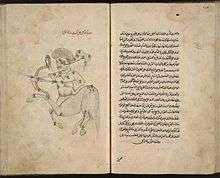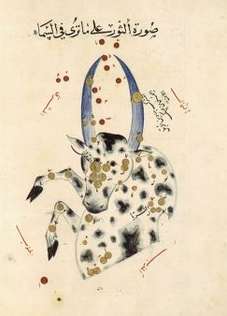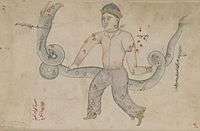Abd al-Rahman al-Sufi
'Abd al-Rahman al-Sufi (Persian: عبدالرحمن صوفی (December 7, 903 in Rey, Iran – May 25, 986 in Shiraz, Iran) was a Persian[1][2][3] astronomer also known as 'Abd ar-Rahman as-Sufi, 'Abd al-Rahman Abu al-Husayn, 'Abdul Rahman Sufi, or 'Abdurrahman Sufi and, historically, in the West as Azophi and Azophi Arabus.[4] The lunar crater Azophi and the minor planet 12621 Alsufi are named after him. Al-Sufi published his famous Book of Fixed Stars in 964, describing much of his work, both in textual descriptions and pictures. Al-Biruni reports that his work on the ecliptic was carried out in Shiraz. He lived at the Buyid court in Isfahan.
'Abd al-Rahman al-Sufi | |
|---|---|
| Born | December 7, 903 Rey, Buyid Persia |
| Died | May 25, 986 (aged 82) Shiraz, Buyid Persia |
| Occupation | Astronomer |
| Era | Islamic Golden Age |
Notable work | Book of Fixed Stars |
Biography
'Abd al-Rahman al-Sufi was one of the nine famous Muslim astronomers. His name implies that he was from a Sufi Muslim background. He lived at the court of Emir Adud ad-Daula in Isfahan, Persia, and worked on translating and expanding Greek astronomical works, especially the Almagest of Ptolemy. He contributed several corrections to Ptolemy's star list and did his own brightness and magnitude estimates which frequently deviated from those in Ptolemy's work, with only 55% of Al-Sufi's magnitudes being identical to Ptolemy's.[5]
He was a major contributor of translation into Arabic of the Hellenistic astronomy that had been centered in Alexandria, Egypt, the first to attempt to relate the Greek with the traditional Arabic star names and constellations, which were completely unrelated and overlapped in complicated ways.
Astronomy

Al-Sufi made his astronomical observations at a latitude of 32.7° in Isfahan.[5] He identified the Large Magellanic Cloud, which is visible from Yemen, though not from Isfahan; it was not seen by Europeans until Magellan's voyage in the 16th century.[6][7] He also made the earliest recorded observation of the Andromeda Galaxy in 964 AD; describing it as a "small cloud".[8] These were the first galaxies other than the Milky Way to be observed from Earth.
Al-Sufi published Kitab al-Kawatib al-Thabit al-Musawwar (also commonly known as the Book of Fixed Stars) in AD 964 and dedicated it to Adud al-Dawla, the current ruler of Buwayhid at the time.[9] This book describes forty-eight constellations and the stars that they are composed of. Within the Book of Fixed Stars, Al-Sufi compared Greek and Arabic constellations and stars to equate the same ones to each other. [10] He included two illustrations of each constellation, one showing the orientation of the stars from the perspective of outside the celestial globe and the other from the perspective of looking at the sky while standing on the earth. He separated the constellations into three groups: twenty-one northern constellations, twelve zodiac constellations, and fifteen southern constellations. For each of these forty-eight constellations, Al-Sufi provided a star chart that contains all of the stars that form the constellation. Each star chart names and numbers the individual stars in the constellation, provides their longitudinal and latitudinal coordinates, the magnitude or brightness of each star, and its location north or south of the ecliptic.[9] Although the magnitude was given for each star, of the 35 remaining copies of the Book of Fixed Stars[11] the star magnitudes are not consistently the same number for each star due to scribal error.[12] Al-Sufi organized the stars in each of his drawings into two groups: the stars that form the image that the constellation is meant to depict, and the stars that are in close proximity to the constellation but do not contribute to the overall image. He identified and described stars that Ptolemy did not, but he did not include them in his star charts. Al-Sufi states at the beginning of the Book of Fixed Stars that his charts are modeled after those that were produced by Ptolemy, so Al-Sufi left them out of his charts as well.[9]
Eight hundred thirty-nine years had passed since Ptolemy had published the Almagest, so the longitudinal placement of the stars within constellations had changed. To account for the procession of the stars, Al-Sufi added 12° 42' to the longitudes Ptolemy had previously suggested for the placement of the stars.[13] Al-Sufi differed in Ptolemy by having a three leveled scale to measure the magnitude of stars instead of a two leveled scale. This extra level increased the accuracy of his measurements. His methods of determining these magnitude measurements cannot be found in any remaining texts.[5]
Despite the importance of the Book of Fixed Stars in the history of astronomy, there is no English translation of the work.[11]
Al-Sufi observed that the ecliptic plane is inclined with respect to the celestial equator and more accurately calculated the length of the tropical year.
Al-Sufi also wrote about the astrolabe, finding numerous additional uses for it: he described over 1000 different uses, in areas as diverse as astronomy, astrology, horoscopes, navigation, surveying, timekeeping, Qibla, Salat prayer, etc.[14]
Al-Sufi's astronomical work was used by many other astronomers that came soon after him, including Ulugh Beg who was both a prince and astronomer.[9]
Tribute
Since 2006, Astronomy Society of Iran – Amateur Committee (ASIAC) hold an international Sufi Observing Competition in the memory of Al-Sufi. The first competition was held in 2006 in the north of Semnan Province[15] and the second was held in the summer of 2008 in Ladiz near the Zahedan. More than 100 attendees from Iran and Iraq participated in the event.[16]
On December 7, 2016, Google Doodle commemorated his 1113th birthday.[17]
Gallery
See also
- List of Iranian scientists
- List of Muslim scientists
- Astronomy in Islam
- Al Sufi's Cluster
References
- Al-Qifti. Ikhbar al-'ulama' bi-akhbar al-hukama ("History of Learned Men"). In: Άbdul-Ramān al-Şūfī and his Book of the Fixed Stars: A Journey of Re-discovery by Ihsan Hafez, Richard F. Stephenson, Wayne Orchiston (2011). In: Orchiston, Wayne, Highlighting the history of astronomy in the Asia-Pacific region: proceedings of the ICOA-6 conference. Astrophysics and Space Science Proceedings. New York: Springer. ISBN 978-1-4419-8161-5. "... is the honored, the perfect, the most intelligent and the friend of the King Adud al-Dawla Fanakhasru Shahenshah Ibn Buwaih. He is the author of the most honored books in the science of astronomy. He was originally from Nisa and is of a Persian descent."
- Robert Harry van Gent. Biography of al-Sūfī. "The Persian astronomer Abū al-Husayn ‘Abd al-Rahmān ibn ‘Umar al-Sūfī was born in Rayy (near Tehrān) on 7 December 903 [14 Muharram 291 H] and died in Baghdād on 25 May 986 [13 Muharram 376 H] ... the Persian astronomer Abū al-Husayn ‘Abd al-Rahmān ibn ‘Umar al-Sūfī who was commonly known by European astronomers as Azophi Arabus". University of Utrecht, Netherlands. Retrieved January 11, 2014
- Selin, Helaine (2008). Encyclopaedia of the history of science, technology, and medicine in non-western cultures. Berlin New York: Springer. p. 160. ISBN 9781402049606.
Al-Sūf ī was an astronomer in the Arabic–Islamic area. He was of Persian origin, but wrote in Arabic, the language of all science in that time.
- Robert Harry van Gent. Biography of al-Sūfī. "The Persian astronomer Abū al-Husayn ‘Abd al-Rahmān ibn ‘Umar al-Sūfī was born in Rayy (near Tehrān) on 7 December 903 [14 Muharram 291 H] and died in Baghdād on 25 May 986 [13 Muharram 376 H] ... the Persian astronomer Abū al-Husayn ‘Abd al-Rahmān ibn ‘Umar al-Sūfī who was commonly known by European astronomers as Azophi Arabus". University of Utrecht, Netherlands. Retrieved January 11, 2014
- Schaefer, Bradley E. (February 2013). "The Thousand Star Magnitudes in the Catalogues of Ptolemy, Al Sufi, and Tycho are All Corrected for Atmospheric Extinction". Journal for the History of Astronomy. 44 (1): 47–A91. arXiv:1303.1833. Bibcode:2013JHA....44...47S. doi:10.1177/002182861304400103. ISSN 0021-8286.
- "Observatoire de Paris (Abd-al-Rahman Al Sufi)". Archived from the original on 2007-04-16. Retrieved 2007-04-19.
- "Observatoire de Paris (LMC)". Archived from the original on 2007-04-17. Retrieved 2007-04-19.
- Kepple, George Robert; Glen W. Sanner (1998). The Night Sky Observer's Guide. 1. Willmann-Bell. p. 18. ISBN 0-943396-58-1.
- Hafez, Ihsan; Stephensen, Richard; Orchiston, Wayne, (January 1, 2011),Abdul-Rahman al-Sufi and his Book of the Fixed Stars, pp. 121-138, ISBN 9781441981615, retrieved November 13, 2019
- Cavin, Jerry D. (2012). The Amateur Astronomer's Guide to the Deep-Sky Catalogs. Springer Science+Business Media, LLC. ISBN 978-1-4614-0656-3. OCLC 759795491.
- Orchiston, Wayne; Green, David A.; Strom, Richard (November 24, 2014). New Insights From Recent Studies in Historical Astronomy: Following in the Footsteps of F. Richard Stephenson: A Meeting to Honor F. Richard Stephenson on His 70th Birthday. Springer. ISBN 978-3-319-07614-0.
- Knobel, E. B. (June 1885). "On Al Sufi's star magnitudes". Monthly Notices of the Royal Astronomical Society. 45: 417–425. Bibcode:1885MNRAS..45..417K. doi:10.1093/mnras/45.8.417.
- Upton, Joseph M (March 1933). "A Manuscript of "The Book of the Fixed Stars" by ʿAbd Ar-Raḥmān Aṣ-Ṣūfī". Metropolitan Museum Studies. 4: 179–197. doi:10.2307/1522800. JSTOR 1522800.
- Dr. Emily Winterburn (National Maritime Museum) (2005). "Using an Astrolabe". Foundation for Science Technology and Civilisation. Retrieved 2008-01-22.
- "Archived copy". Archived from the original on 2009-10-20. Retrieved 2009-01-07.CS1 maint: archived copy as title (link)
- رقابت صوفي، درآمدي بر سال جهاني نجوم
- "Abd al-Rahman Al-Sufi's (Azophi) 1113th Birthday". December 7, 2016.
Sources
- "Abd al-Rahman Al-Sufi's (Azophi) 1113th Birthday". Google.com. December 7, 2016.
- Al-Qifti. Ikhbar al-'ulama' bi-akhbar al-hukama ("History of Learned Men"). In: Άbdul-Ramān al-Şūfī and his Book of the Fixed Stars: A Journey of Re-discovery by Ihsan Hafez, Richard F. Stephenson, Wayne Orchiston (2011). In: Orchiston, Wayne, Highlighting the history of astronomy in the Asia-Pacific region: proceedings of the ICOA-6 conference. Astrophysics and Space Science Proceedings. New York: Springer. ISBN 978-1-4419-8161-5. "... is the honored, the perfect, the most intelligent and the friend of the King Adud al-Dawla Fanakhasru Shahenshah Ibn Buwaih. He is the author of the most honored books in the science of astronomy. He was originally from Nisa and is of a Persian descent."
- "Archived copy". Archived from the original on 2009-10-20. Retrieved 2009-01-07.
- Cavin, Jerry D. (2012). The amateur Astronomer's Guide to the Deep-Sky Catalogs. Springer Science+Business Media, LLC. ISBN 978-1-4614-0656-3. OCLC 759795491.
- Dr. Emily Winterburn (National Maritime Museum) (2005). "Using an Astrolabe". Foundation for Science Technology and Civilisation. Retrieved 2008-01-22.
- Hafez, Ihsan; Stephensen, Richard; Orchiston, Wayne, (2011-01-01),Abdul-Rahman al-Sufi and his Book of the Fixed Stars, pp. 121-138, ISBN 9781441981615, retrieved 2019-11-13.
- Kepple, George Robert; Glen W. Sanner (1998). The Night Sky Observer's Guide. 1. Willmann-Bell. p. 18. ISBN 0-943396-58-1.
- Knobel, E. B. (June 1885). "On Al Sufi's star magnitudes". Monthly Notices of the Royal Astronomical Society. 45: 417-425.
- "Observatoire de Paris (Abd-al-Rahman Al Sufi)". Archived from the original on April 16, 2007. Retrieved 2007-04-19.
- "Observatoire de Paris (LMC)". Archived from the original on April 17, 2007. Retrieved 2007-04-19.
- Orchiston, Wayne; Green, David A.; Strom, Richard (2014-11-24). New Insights From Recent Studies in Historical Astronomy: Following in the Footsteps of F. Richard Stephenson: A Meeting to Honor F. Richard Stephenson on His 70th Birthday. Springer. ISBN 978-3-319-07614-0.
- Robert Harry van Gent. Biography of al-Sūfī. "The Persian astronomer Abū al-Husayn ‘Abd al-Rahmān ibn ‘Umar al-Sūfī was born in Rayy (near Tehrān) on 7 December 903 [14 Muharram 291 H] and died in Baghdād on 25 May 986 [13 Muharram 376 H] ... the Persian astronomer Abū al-Husayn ‘Abd al-Rahmān ibn ‘Umar al-Sūfī who was commonly known by European astronomers as Azophi Arabus". University of Utrecht, Netherlands. Retrieved 2014-01-11.
- Schaefer, Bradley E. (2013-02). "The Thousand Star Magnitudes in the Catalogues of Ptolemy, Al Sufi, and Tycho are All Corrected for Atmospheric Extinction". Journal for the History of Astronomy. 44 (1): 47-A91. doi: 10.1177/002182861304400103. ISSN 0021-8286.
- Selin, Helaine (2008). Encyclopedia of the history of science, technology, and medicine in non-western cultures. Berlin New York: Springer. p. 160. ISBN 9781402049606. Al-Sūfī was an astronomer in the Arabic-Islamic area. He was of Persian origin, but wrote in Arabic, the language of all science in that time.
- Upton, Joseph M (March 1933). "A Manuscript of "The Book of the Fixed Stars" by 'Abd Ar-Rahmān As-Sūfī". Metropolitan Museum Studies. 4: 179-197 - via JSTOR.
External links
- Liber locis stellarum fixarum, 964 da www.atlascoelestis.com
- Liber locis stellarum fixarum, 964, manoscritto del 1417 riprodotto il 1730 da www.atlascoelestis.com
- Ulug Beg in www.atlascoelestis.com
- Al-Sufi's constellations
- Al-Sūfī’s Book of the Constellations of the Fixed Stars and its Influence on Islamic and Western Celestial Cartography





